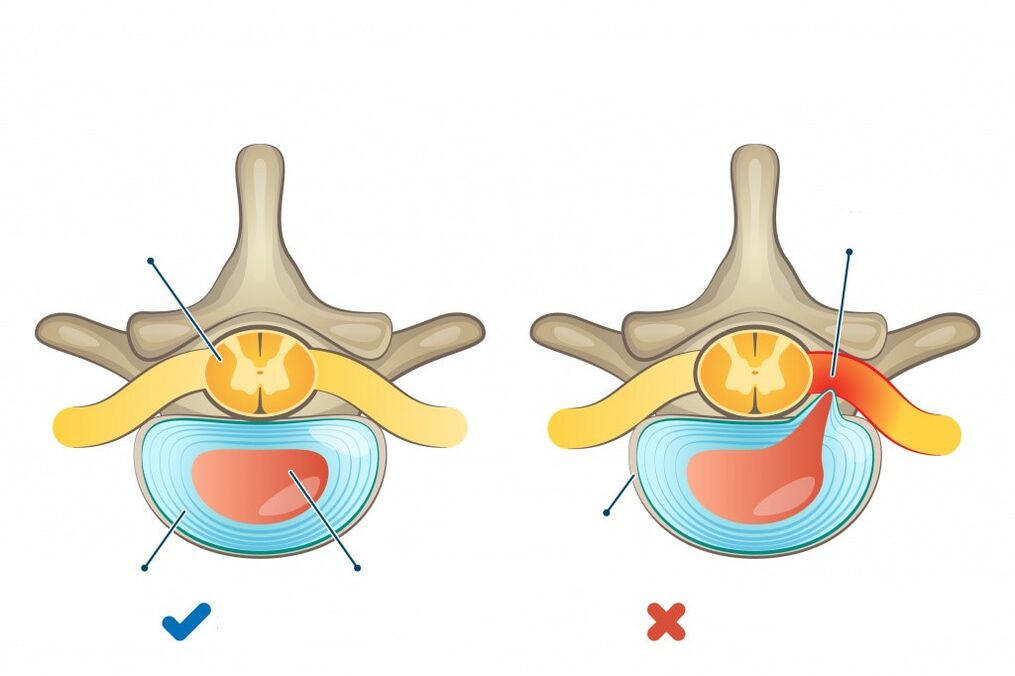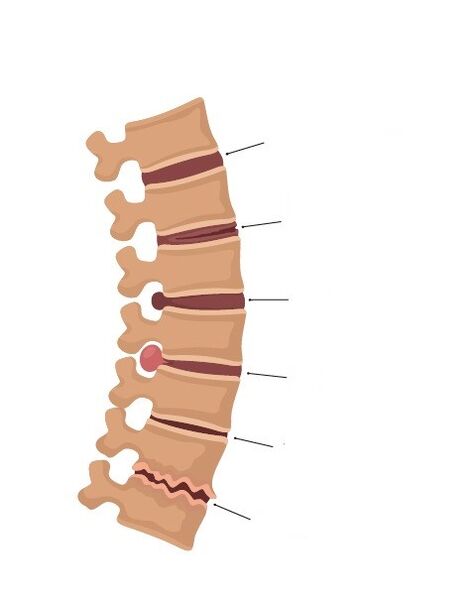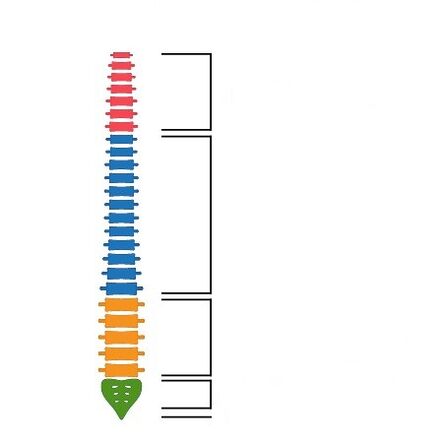The spine includes the cervical, thoracic and lumbosacral sections and consists of 33-34 vertebrae arranged one above the other and connected into a single chain.In order to evenly distribute the load on the spine during everyday physical activity and in an upright posture, the spine has physiological (normal) curvatures.Two curves convex forward in the neck and lumbar region (lordosis) and two convex curves backward in the thoracic and sacral region (kyphosis).Between the vertebrae there are intervertebral discs - cartilage, which perform a shock-absorbing function and consist of the nucleus pulposus and the fibrous ring surrounding it.

Spinal osteochondrosis is a chronic disease characterized by the development of degenerative-dystrophic changes in the intervertebral discs with subsequent involvement of adjacent vertebrae and surrounding tissues.
Today, doctors more commonly use the broader term “dorsopathy” to refer to pain in the back and neck, sometimes replacing the term “osteochondrosis.”Dorsopathy includes pain in the neck (cervicalgia), neck and headache (cervicocranialgia), neck and shoulder pain (cervicobrachialgia), chest pain (thoracicgia), lower back pain (lumbodynia), and lower back pain radiating to the leg (lumboischialgia).
Causes of spinal osteochondrosis
There is currently no precise data on the causes of degenerative changes in the spine.There are a number of theories that take into account various factors: involution (involution – reverse development, backward movement), mechanical, immunological, hormonal, dysmetabolic (metabolic), vascular, infectious, functional and hereditary.The most common is the involutive theory, according to which local (local) premature aging of cartilage and bone occurs as a result of previous mechanical or inflammatory damage.According to this theory, the development of degenerative changes in the spine is genetically predetermined and the occurrence of the disease with corresponding clinical manifestations is due to the influence of various endogenous (internal) and exogenous (external) factors.
The likelihood of osteochondrosis increases with age, with obesity, lack of exercise and poor physical fitness on the one hand and heavy physical work and vibration exposure on the other.
The load on the spine increases proportionally with the increase in body weight, so overweight people suffer from overload even with moderate activity;The situation is exacerbated by a tendency towards physical inactivity due to low tolerance for physical activity.
Psycho-emotional stress, coupled with a sedentary lifestyle, leads to tension in individual muscle groups, changes in muscle tone and movement patterns - posture, gait.The development of scoliosis – lateral curvature of the spine, pathological kyphosis and lordosis (aggravation of physiological curvatures) also contributes to the deformation of the intervertebral discs.
Classification of the disease

By localization:
- osteochondrosis of the cervical spine;
- osteochondrosis of the thoracic spine;
- Osteochondrosis of the lumbar and sacral spine.
Depending on the phase of the illness:
- exacerbation (maximum number of clinical manifestations);
- Remission (absence of clinical manifestations).
Depending on which formations are pathologically affected, the affected structures of the spine are distinguished:
- Reflex syndromes - reflex tension of innervated muscles or muscle tone disorders (muscle cramps), vascular, vegetative, dystrophic - arise when pain receptors are irritated.
- Compression syndromes often develop against the background of protrusion (bulging, protrusion of the intervertebral disc beyond the spine without affecting the integrity of the fibrous ring) or herniation of the intervertebral disc due to compression of a nerve root, spinal cord or vessel (accordingly, radiculopathy, neuropathy, myelopathy and radiculoischemic syndrome are distinguished).
Depending on the stage of development of the process, there are:
- Stage of the intradiscal pathological process (chondrosis).During this time there is intradiscal movement of the nucleus pulposus.The nucleus pulposus penetrates its outer fibers through cracks in the fibrous ring.This irritates nerve endings and causes pain.
- The stage of instability or loss of fixation ability of the affected intervertebral disc when the vertebra above it is displaced in relation to the vertebra below.During this time, instability syndromes, reflex and even compression syndromes can form.
- The stage of formation of intervertebral disc herniation due to a violation of the integrity of the fibrous ring, which can compress the adjacent neurovascular formations, including the root of the spinal nerve.
- The stage of fibrosis of the intervertebral discs and the formation of marginal osteochondral growths of the vertebral bodies lead to immobility of the vertebrae and a compensatory increase in their contact surface on defective intervertebral discs.In some cases, these bony growths, such as herniated discs, can compress adjacent neurovascular formations.
Symptoms of osteochondrosis

The symptoms of osteochondrosis depend on the area of spinal damage and the degree of changes occurring in it; in addition, the function of internal organs may be impaired.
Osteochondrosis of the cervical spine is characterized by pain in the neck, which increases with movement, radiates to the arm and is accompanied by numbness in the fingers.
Possible symptoms include headaches in the back of the head, dizziness, tinnitus, darkening of the eyes or flickering of spots in front of the eyes.
If the thoracic spine is affected, patients may experience pain in the heart area, in the area between the shoulder blades, which lasts for a long time, aches or presses, often sharp, stabbing, sharp.
They can occur or increase with deep breathing, bending and turning the body, raising the arms, sneezing and coughing.Numbness of the skin in the chest, stomach and back areas may occur.
With osteochondrosis of the lumbosacral region, patients note stiffness of movements, pain in the lower back, which can radiate to one or both legs and intensify when bending, turning the body, walking and lifting heavy objects.
Possible vegetative disorders: chilliness of the legs at a comfortable temperature for the rest of the body, paleness of the skin of the legs.There is a feeling of numbness and paresthesia (tingling sensation) on the skin of the legs and buttocks.
Diagnosis of the disease
Instrumental diagnostics includes an X-ray of the spine to exclude traumatic injuries, congenital structural anomalies and to identify bone growths.The study is also carried out with functional tests - recordings during flexion and extension in the cervical and lumbar regions in order to exclude pathological displacement of the vertebrae relative to each other.
























